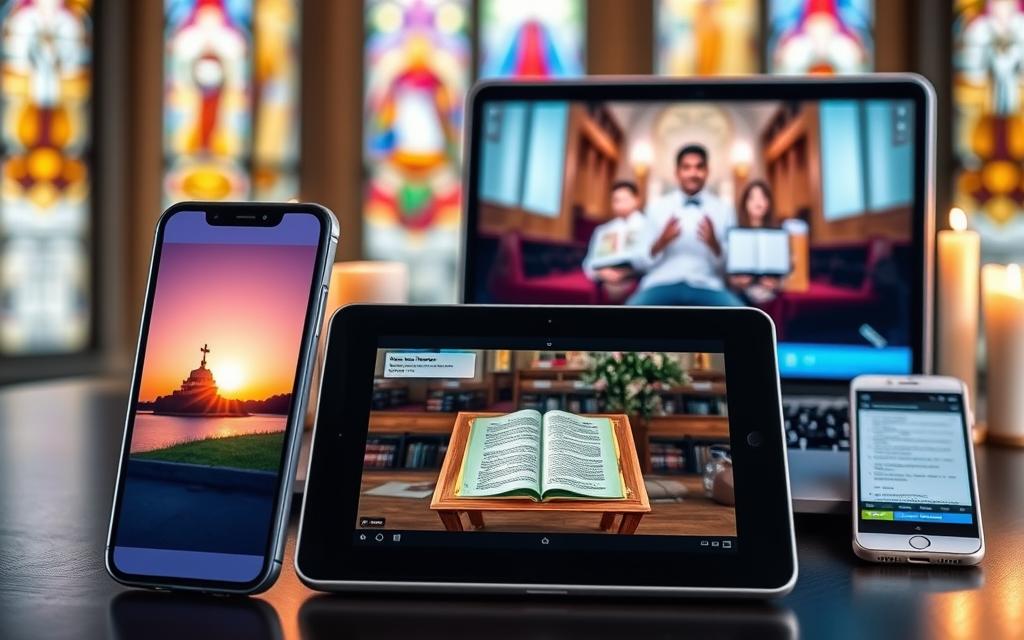The advent of technology has profoundly influenced various aspects of life, including religion. The way people practice and engage with their faith has undergone significant changes in the 21st century.
The publication and translation of sacred texts into various languages have enabled more individuals to read and understand scriptures themselves, unlike the traditional reliance on clergy for interpretation.
This transformation has created new forms of religious communities that transcend geographical boundaries, presenting both opportunities and challenges for faith traditions worldwide.
The Digital Transformation of Faith
The intersection of technology and religion has a rich history, marked by pivotal moments of change. The way people practice their faith has been influenced by technological advancements throughout history.
From Printing Press to Smartphones: A Historical Perspective
The introduction of the printing press in 15th-century Europe revolutionized the spread of religious texts, making it possible to mass-produce books. This technological breakthrough allowed newly formed Protestant groups to disseminate their ideas about Christianity, while the Catholic Church sought to control the distribution of works considered heretical. The printing press democratized access to religious knowledge, shifting the authority from traditional religious institutions to individual believers.
The Democratization of Religious Knowledge
In today’s digital age, smartphones and mobile technology have further transformed the way people engage with their faith. Individuals can now access religious texts, teachings, and communities from anywhere in the world. This unprecedented access to information has empowered people to customize their faith experiences, challenging traditional religious authority structures.
| Technological Innovation | Impact on Religion |
|---|---|
| Printing Press | Mass production of religious texts, spreading Protestant ideas |
| Smartphones | Access to religious texts, teachings, and communities globally |
| Internet | Democratization of religious knowledge, challenging traditional authority |
The digital transformation of faith has opened new avenues for religious expression and community building. As technology continues to evolve, it is likely to further reshape the way people practice their faith.
How Has Technology Impacted Religion Through Social Media
Social media platforms have become pivotal in shaping religious expression and community building. The democratization of religious knowledge is on full display as people can now access a wide range of religious content, from various sources, at any time.

Religious Communities in the Digital Space
The internet has enabled the formation of religious communities that transcend geographical boundaries. On platforms like Instagram and TikTok, individuals can connect with others who share their faith, creating a sense of belonging and spiritual connection. These online communities allow believers to engage in discussions, share their experiences, and support one another.
When Faith Goes Viral: Religious Content Creation
The rise of social media has led to an explosion of religious content creation. Influencers and content creators share their faith journeys, teachings, and religious practices, often using short-form videos and hashtags like #diwali and #easter. Algorithms on platforms like TikTok and YouTube create “digital faith bubbles” where users are exposed to religious content tailored to their interests.
This phenomenon raises important questions about the authenticity and theological accuracy of viral religious content. As complex religious teachings are condensed into bite-sized formats, there is a risk of oversimplification. Nonetheless, social media has opened new avenues for religious expression and community building, revolutionizing the way people engage with their faith.
Virtual Worship and Online Religious Services
The digital age has transformed traditional religious practices in unprecedented ways. With the advent of streaming services and live broadcasts, attending religious services no longer requires physical presence. Individuals can now participate in religious celebrations from the comfort of their own homes or while on the go.
Livestreaming Religious Ceremonies
The COVID-19 pandemic has accelerated the adoption of virtual worship services across various faith traditions globally. Religious institutions have adapted their worship practices to incorporate livestreaming, virtual attendance, and online participation. This shift has opened up new possibilities for inclusivity and accessibility.
Livestreaming religious ceremonies has become a norm, allowing churches and religious organizations to reach a wider audience. This has been particularly beneficial for individuals who are unable to attend physical services due to disability or geographic isolation.
Creating Inclusive Access to Religious Practices
Virtual worship has created unprecedented accessibility for individuals who were previously excluded from religious services. The use of technology has enabled religious communities to expand their reach and include more people in their practices.
| Benefits | Challenges |
|---|---|
| Increased accessibility for people with disabilities | Technical issues during livestreaming |
| Geographic isolation no longer a barrier | Theological challenges in virtual spaces |
| Expanded reach for religious communities | Maintaining spiritual significance in virtual worship |
The shift to virtual worship represents a significant change in how religious communities gather and practice their faith. As technology continues to evolve, it is likely that virtual worship will remain a vital part of religious life.
Religious Apps and Digital Tools
As technology advances, religious institutions are leveraging digital tools to enhance spiritual practices. This shift has led to the development of various applications catering to different aspects of religious life.
Prayer and Meditation Apps
Prayer and meditation apps have become increasingly popular, offering guided sessions and personalized spiritual experiences. These apps, such as Headspace and Calm, provide users with tools to deepen their faith and manage stress.
Digital Religious Texts and Resources
Digital versions of religious texts have made scriptures more accessible. Apps like YouVersion offer multiple translations, commentaries, and audio versions of the Bible, Koran, and other holy books, enhancing the study and understanding of religious texts.
Community-Building Applications
Community-building apps connect believers for prayer, discussion, and mutual support. These platforms enable religious leaders to extend their ministry beyond physical gatherings, fostering a sense of community among users.
| App Type | Features | Benefits |
|---|---|---|
| Prayer and Meditation | Guided sessions, personalized experiences | Deepens faith, reduces stress |
| Digital Religious Texts | Multiple translations, commentaries, audio versions | Enhances scripture study, increases accessibility |
| Community-Building | Prayer groups, discussion forums | Fosters community, extends ministry |

Artificial Intelligence in Religious Contexts
Artificial intelligence is making its mark on religion, from AI-assisted religious leadership to robot priests. The integration of AI in religious contexts is transforming the way people practice their faith and interact with religious institutions.
AI-Assisted Religious Leadership
Some religious leaders have embraced AI development to enhance their ministry. For instance, Priest Caru Das Adhikary at Utah’s Sri Sri Radha Krishna Temple uses AI for composing religious music, noting, “I use AI for practically every single composition I make.” He relies on Google Gemini to turn Sanskrit Hare Krishna text into rap, demonstrating how AI can be a tool for creative expression in faith.
Robot Priests and Digital Spiritual Guides
The use of robot priests is another emerging trend. In Beijing’s Longquan Temple, a robot named Xian’er chants Buddhist mantras and explains the basic principles of faith. According to National Geographic, such technological advancements are changing the way religious teachings are disseminated.

The intersection of AI and religion raises important questions about the future of spiritual practices. As technologies continue to evolve, they will likely play a larger part in worship and religious life. For more insights on how technology affects people, visit TechHack.
| Aspect | Traditional | AI-Enhanced |
|---|---|---|
| Religious Leadership | Human-led sermons | AI-assisted sermon preparation |
| Spiritual Guidance | Human advisors | AI chatbots and virtual advisors |
| Community Building | Physical gatherings | Online forums and AI-facilitated discussions |
The Global Digital Divide in Religious Practice
As technology continues to advance, its impact on religious practices varies greatly across different regions and communities. The disparity in technology adoption has created a digital divide in religious practices, affecting how people engage with their faith.
Regional Differences in Technology Adoption
Regional differences play a significant role in technology adoption for religious purposes. In the United States, for instance, there’s been a decline in religious belief, with 81% of Americans believing in God in 2022, down from 98% in 1952. In contrast, regions like the Middle East, South Asia, and Latin America are experiencing growth in religious practices.  The use of technology in these regions is also on the rise, with many religious communities leveraging digital tools to enhance their practices.
The use of technology in these regions is also on the rise, with many religious communities leveraging digital tools to enhance their practices.
Cultural and Economic Factors
Cultural attitudes towards technology and economic factors significantly influence its adoption in religious contexts. Wealthier congregations can afford to invest in livestreaming equipment and other digital tools, while less affluent communities may rely on traditional methods. Religious organizations are working to bridge this divide by increasing technological access and literacy among underserved communities. By doing so, they aim to make religious practices more inclusive and accessible to a broader audience.
Challenges and Concerns in the Digital Religious Landscape
With the rise of digital religious spaces, issues such as misinformation, privacy concerns, and superficial faith experiences have become more prevalent. As people increasingly turn to online platforms for their spiritual needs, it’s crucial to address these challenges to ensure a meaningful and safe religious experience.
Authenticity and Authority in Online Religious Spaces
The proliferation of online religious content has raised concerns about authenticity and authority. With numerous sources of religious information available, individuals may encounter misinformation or extremist content that can be detrimental to their faith. It’s essential to verify the credibility of online religious sources, such as checking if they are affiliated with reputable institutions or authors. For instance, a study on the impact of digital technology on religious practices highlights the need for critical evaluation of online content scholarly research.
Privacy and Data Ethics in Religious Technology
Religious apps and platforms often collect sensitive data about users’ spiritual lives, beliefs, and practices, raising significant privacy concerns. Users must be aware of how their data is being used and protected. Some apps may share data with third parties or use it for targeted advertising, potentially infringing on users’ privacy. Understanding the terms of service and privacy policies of these platforms is crucial.
The Risk of Superficial Faith Experiences
The convenience of digital religious experiences can sometimes come at the expense of depth and commitment. With the ease of accessing religious content online, individuals may engage in superficial religious practices without fully immersing themselves in the community or spiritual practices. For example, some members of the congregation may be distracted by their smartphones during sermons, missing out on the full spiritual experience. As noted by experts, the current generation of technology is significantly influencing how people interact with religious content current tech generation.

- The digital divide may exacerbate existing inequalities in accessing religious resources.
- There’s a risk of over-reliance on technology for spiritual guidance.
- Digital distractions during physical worship services can alter the nature of religious attention.
Conclusion: The Future of Religion in a Technological World
In today’s digital world, the relationship between technology and religion is evolving, prompting religious leaders to rethink their strategies for engaging with believers. As we’ve explored, technology has transformed the way individuals practice their faith, from virtual worship services to online religious communities.
The rise of emerging technologies like virtual reality and augmented reality is poised to create new forms of religious experience and community. Religious institutions are adapting to remain relevant in an increasingly digital world while preserving their core tradition. This balance between embracing innovation and maintaining authentic spiritual experiences is crucial.
As social media continues to play a significant role in shaping religious discourse, religious leaders must navigate the opportunities and challenges it presents. By leveraging social media and other digital tools, religious communities can enhance their outreach and engagement. Ultimately, the future of religion in a technological world will depend on finding a balance between tradition and innovation, ensuring that religion remains a vital part of our lives today and in the future.







